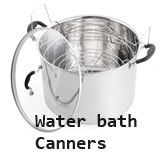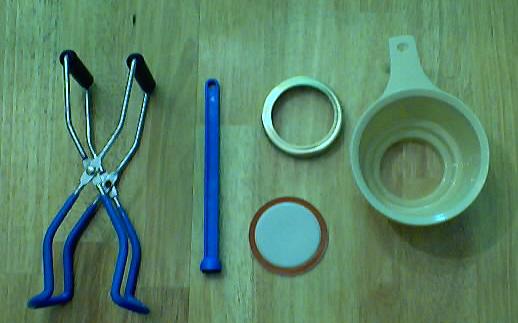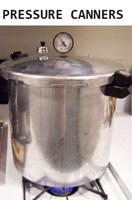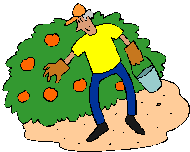
Looking for Making Home-made Sweet Gherkin Pickles - Easy, Fully Illustrated Instructions and Recipe! in 2025? Scroll down this page and follow the links. And if you bring home some fruit or vegetables and want to can, freeze, make jam, salsa or pickles, see this page for simple, reliable, illustrated canning, freezing or preserving directions. There are plenty of other related resources, click on the resources dropdown above. If you are having a hard time finding canning lids, I've used these, and they're a great price & ship in 2 days.
If you have questions or feedback, please let me know! There are affiliate links on this page. Read our disclosure policy to learn more.
Making Home-made Sweet Gherkin Pickles - Easy, Fully Illustrated Instructions and Recipe!
Making Home-made Sweet Gherkin Pickles!
Yield: 6 to 7 pint jars
Click here for a PDF print version
Making and canning your own sweet pickled gherkins the old-fashioned way, with all natural ingredients has never been easier!! Here's how to do it, in easy steps and completely illustrated. This method is so easy, ANYONE can do this! It's a great thing to do with your kids! This is an easy recipe, but it is spread out over 3 days, while the cucumbers soak up brine!
Click here for the page of frequently asked questions (with answers) about making pickles.
Ingredients
- 7 lbs cucumbers (1-1/2 inch or less)
- 1/2 cup canning or pickling salt
- 8 cups sugar
- 6 cups white vinegar (5 percent)
- 3/4 teaspoons turmeric
- 2 teaspoons celery seeds
- 2 teaspoons whole mixed pickling spice
- 2 cinnamon sticks
- 1/2 teaspoon fennel (optional)
- 2 teaspoons vanilla (optional)
Equipment
- Jar grabber (to pick up the hot jars)
- Lid lifter (I like the lid rack that holds 12 lids or you can pull them out one at a time with the lid-lifter that has a magnet from the almost-boiling water where you sanitize them. ($4 at Target, other big box stores, and often grocery stores; and available online - see this page)
- Jar funnel ($5 at Target, other big box stores, and often grocery stores; and available online - see this page)
- 1 large pots; Nonstick ceramic coated pots for easy cleanup.
- Large spoons and ladles,
- 1 water bath canner (a huge pot to sanitize the jars after filling (about $30 to $35 at mall kitchen stores, sometimes at big box stores and grocery stores.). Note: we sell many sizes and types of canners for all types of stoves and needs - see canning supplies
- Pint canning jars (Ball or Kerr jars can be found at grocery stores, like Safeway, Publix, Kroger, grocery stores, even online - about $13 per dozen 8-ounce jars, more for quilted design or larger jars, including the lids and rings). Be sure to get wide mouth jars to fit the pickles in! Pint size works best!
- Lids - thin, flat, round metal lids with a gum binder that seals them against the top of the jar. They may only be used once.
- Rings - metal bands that secure the lids to the jars. They may be reused many times.
Directions - How to Make Sweet Gherkin Pickles
Be sure to read all the directions first - there are a couple of options and variations at the end, if you want to make firmer pickles (it's a trade-off; it takes more work!)
Step 1 - Selecting the cucumbers
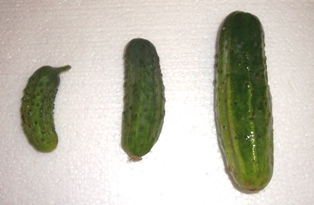 It's fun to go pick your own and you can obviously get better
quality cucumbers!
It's fun to go pick your own and you can obviously get better
quality cucumbers!
At left is a of picture cucumbers from my garden - they are SO easy to grow. But be sure to grow the varieties that are labeled "pickling cucumbers" - they will be much more crisp! Note that only the two on the left will make good gherkins. The cucumber on the right is too big! (it's about 4 inches long)
Step 2 - How many cucumbers?
It takes about 30-plus 1-inch or 15 2-inch cucumbers to fill a pint jar.
Step 3 - Get the jars and lids sanitizing
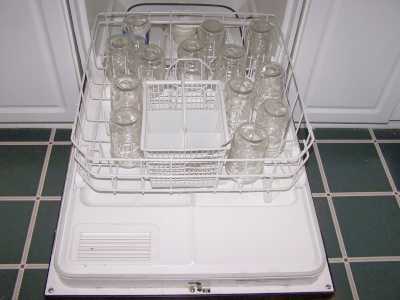
The dishwasher is fine for the jars; especially if it has a "sanitize" cycle.
I get that going while I'm preparing everything else, so it's done by the
time I'm ready to fill the jars. If you don't have a
dishwasher, submerge the jars in a large pot (the canner itself) of
water and bring it to a boil.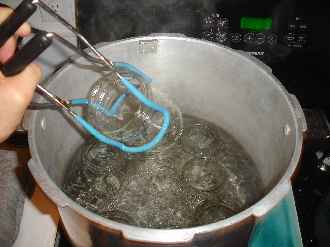
Be sure to let it go through the rinse cycle to get rid of any soap!
Get the canner heating up
Fill the canner about 1/2 full of water and start it heating (with the lid on).
Start the water for the lids
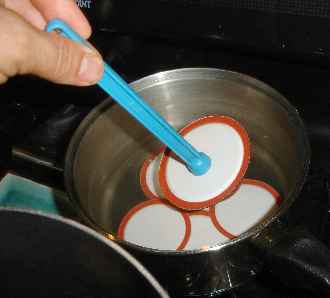 Put the lids into a pan of hot, but not quite boiling water for at least
several minutes. Note: everything gets
sanitized in the water
bath (step 7)
anyway, so this just helps to ensure
there is no spoilage later!)
Put the lids into a pan of hot, but not quite boiling water for at least
several minutes. Note: everything gets
sanitized in the water
bath (step 7)
anyway, so this just helps to ensure
there is no spoilage later!)
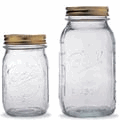
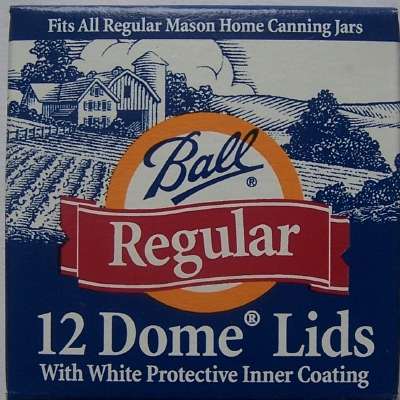
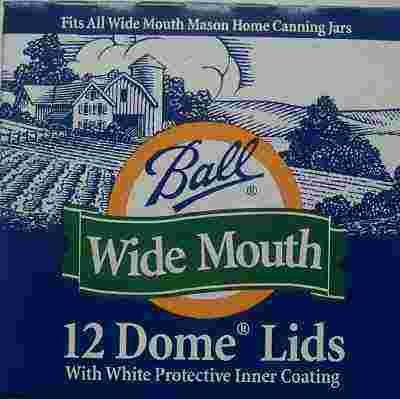 Need lids, rings and replacement jars?
Need lids, rings and replacement jars?
Get them all here, delivered direct to your home, at the best prices on the internet!
Step 4 -Wash and cut the cukes!
I'm sure you can figure out how to wash the cucumbers in plain cold water.
You will need to cut a 1/16-inch slice off the blossom end of the cucumbers and discard, but you can leave the stem end and 1/4-inch of the stem attached, or slice it off, as you prefer. Then cut the cukes into 3/16-inch slices, cross-wise.
Step 5 - Put cucumbers in a large bowl. (Day 1)
Place cucumbers in large container and cover with boiling water. Six to 8 hours later (Day 2), drain and cover with 6 quarts of fresh boiling water containing 1/4-cup salt. If you do this late in the evening, then you can cover it, set on the counter and return in the morning. If it will be longer than 8 hours, let it cool to room temp, then store in the fridge.
Step 6 - Day 2 morning - Drain and re-fill
The next morning (or 6 to 8 hours later), drain and cover with 6 quarts of fresh boiling water containing 1/4-cup salt. If it will be sitting for longer than 8 hours, let it cool to room temp, then store in the fridge.
Step 7 - Day 3 morning - Drain and fork
On the third day, drain and prick cucumbers with a table fork and continue to step 8.
Step 8 - Combine the other ingredients in a separate pot and boil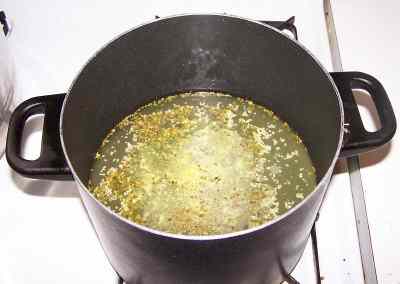
Combine
- 3 cups vinegar,
- 3 cups sugar,
- 3/4 teaspoons turmeric
- 2 teaspoons celery seeds
- 2 teaspoons whole mixed pickling spice
- 2 cinnamon sticks
- 1/2 teaspoon fennel (optional)
in a large pot and bring to boil
Note: if you need more liquid to cover the cucumbers, just make more of the above in the same proportion (like, 1.5 cups vinegar, 1.5 cups sugar, and 1/2 the amount of the spices above)
Step 9 - Pour the liquid over the cucumbers
Pour over cucumbers and let it rest for 6 to 8 hours, on the counter
Step 10 - Drain and save the liquid
Six to 8 hours later, drain and save the pickling syrup.
Step 11 - Heat the liquid from step 10
Heat the drained liquid to a boil. Add another 2 cups of sugar and 2 cups of vinegar and reheat to boil.
Step 12 - Pour over the cucumbers and let the mix stand
Pour the liquid over the pickles.
Step 13 - Day 4 morning - Drain and save the liquid
On the fourth day, drain and save syrup. Add another 2 cups sugar and 1 cup vinegar. Heat to boiling and pour over pickles. Let it stand for 6 to 8 hours (yes, again!)
Step 14 - Day 4 afternoon - Drain, save, heat (Yep, again)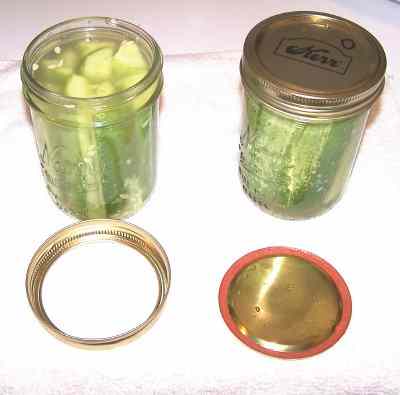
Drain and save pickling syrup 6 to 8 hours later. Add 1 cup sugar and 2 teaspoons vanilla and heat to boiling.
Step 15 - Fill the jars (FINALLY!)
Fill sterile pint jars, with pickles and cover with hot syrup, leaving 1/2-inch headspace. (Note: the photo shows large pickles, not gherkins - just to illustrate filling)
Note about Pickle Mixes
To interject a crass commercial here - hey, I've got to pay for the website somehow :) I have found the best (crispest, best tasting) pickles from a mix are with the "Mrs. Wages Polish Dill Refrigerator Pickle Mix" .
They REALLY are good AND you don't need a canner - you store them in your fridge right after making them. They're ready to eat in 24 hours! Our affiliate sells the mixes (and at really good prices, too)
Whether you want dills or sweet pickles; canning them or straight into the refrigerator; there is a mix for every taste and need here!
Get them all here, delivered direct to your home, at the best prices on the internet! Get everything you need to make pickles: mixes, salt, brine, etc. here!
Step 16 - Process the sealed jars
Adjust lids and process according to one of the two methods below. The first method is easiest, but the second method yields firmer pickles:
a.
Put them
in the canner and keep them covered with at least 1 inch of water. Keep
the water
boiling. Boil them for 10 minutes (or as directed by the instructions with your canner). Remember to adjust for altitudes
(see below) and larger jars! 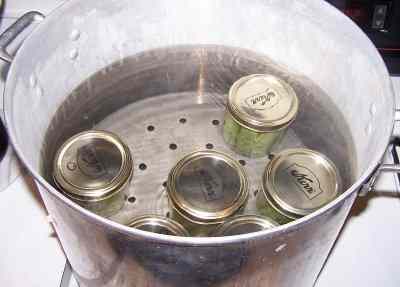
|
Table 1. Recommended process time for Bread-and-Butter Pickles in a boiling-water canner. |
||||
|
|
Process Time at Altitudes of |
|||
|
Style of Pack |
Jar Size |
0 - 1,000 ft |
1,001 - 6,000 ft |
Above 6,000 ft |
|
Hot |
Pints |
5 min |
10 |
15 |
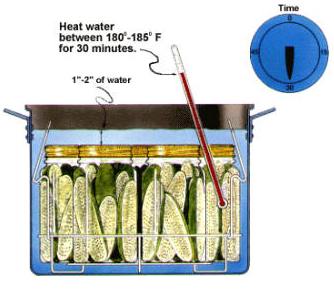
b. OR use this low-temperature pasteurization treatment:.
The following treatment results in a better product texture but must be
carefully managed to avoid possible spoilage.
Place jars in a canner filled half way with warm (120º to 140ºF) water.
Then, add hot water to a level 1 inch above jars.
Heat the water enough to maintain 180 to 185ºF water temperature for 30 minutes.
Check with a candy or jelly thermometer to be certain that the water temperature is at least 180ºF during the entire 30 minutes. Temperatures higher than 185ºF may cause unnecessary softening of pickles.
Step 17 - Done
Lift the jars out of the water and let them cool without touching or bumping them in a draft-free place (usually takes overnight) You can then remove the rings if you like, but if you leave them on, at least loosen them quite a bit, so they don't rust in place due to trapped moisture. Once the jars are cool, you can check that they are sealed verifying that the lid has been sucked down. Just press in the center, gently, with your finger. If it pops up and down (often making a popping sound), it is not sealed. If you put the jar in the refrigerator right away, you can still use it. Some people replace the lid and reprocess the jar, then that's a bit iffy. If you heat the contents back up, re-jar them (with a new lid) and the full time in the canner, it's usually ok.
When can you start eating the pickles? Well, it takes some time for the seasonings to be absorbed into the pickles. After processing and cooling, jars should be stored 4 to 5 weeks to develop ideal flavor. Ah... the wait...
Variation for firmer pickles:
(replace steps 4 to 8 above with these steps instead)
1. Wash cucumbers.
2. Cut 1/16-inch off blossom end and discard. Cut into 3/16-inch slices.
3. Mix 1 cup pickling lime and 1/2 cup salt to 1 gallon water in a 2- to 3-gallon crock or enamelware container. Avoid inhaling lime dust while mixing the lime-water solution.
4. Soak cucumber slices in lime water for 12 to 24 hours, stirring occasionally. I keep them in the fridge during this time.
5. Remove from lime solution, rinse, and resoak 1 hour in fresh cold water.
6. Repeat the rinsing and soaking steps two more times. Handle carefully, as slices will be brittle.
7. Drain well.
Pickle Making Problems?
See this page for a more complete set of frequently asked pickling questions and answers
Summary - Cost of Making Homemade Sweet Gherkin Pickles - makes 6 - 7 pint jars, 16 oz each* |
||||
| Item | Quantity | Cost in 2025 | Source | Subtotal |
| Cucumbers - tiny! | 30-36 per pint jar | free from the garden, or $6.00 at a PYO | Pick your own | $6.00 |
| Canning jars (pint size, wide mouth), includes lids and rings | 7 jars | $8.50/dozen | Grocery stores (Publix, Kroger, Safeway, etc.) | $4.95 |
| Vinegar | 4 cups | $0.99 | Safeway, Publix, Kroger, grocery stores |
$0.99 |
| Sugar | 8 cups | $2.25 | Safeway, Publix, Kroger, grocery stores |
$2.25 |
| Pickling salt | 11/4 cups | $2.00 | Safeway, Publix, Kroger, grocery stores |
$2.00 |
| Dill (fresh or seed) | 7 heads | I grow it, otherwise, I'd use the seed from the grocery: $2.00 | Safeway, Publix, Kroger, grocery stores |
$2.00 |
| Pickle spices | 2 Tablespoons | $2.00 per package, sp about $0.50 | Grocery stores (Publix, Kroger, Safeway, etc.) | $0.50 |
| Total | If you already have jars, the cost is only about $1.85 per jar | $18.00 total or about $2.57 per jar INCLUDING the jars - which you can reuse! |
||
|
* - This assumes you already have the pots, pans, ladles,, and reusable equipment. Note that you can reuse the jars! Many products are sold in jars that will take the lids and rings for canning. For example, Classico Spaghetti sauce is in quart sized jars that work with Ball and Kerr lids and rings. Note that the Classico's manufacturer does not recommend reuse of their jars: see what they have to say on this page: |
||||
How to make other pickles - recipes and instructions:
- Refrigerator pickles (no canning required)
- Cucumber pickle relish
- Pickled beets
- Pickled green beans
- Pickled dilled okra
Can't find the equipment? We ship to all 50 states! Use our Feedback form!
This document was adapted from the "Complete Guide to Home Canning,"
Agriculture Information Bulletin No. 539, USDA, revised 2006.
Reviewed May 2009.
Canning Books, Supplies and Accessories
These are my favorite essential canning tools, books and supplies. I've been using many of these for over 50 years of canning! The ones below on this page are just the sampling of. my preferred tools. but you can find much more detailed and extensive selections on the pages that are linked below.
- Vacuum Foodsealers for freezing, dried foods, and refrigerated foods - the FoodSaver line
- Selecting a KitchenAid mixer and attachments for home canning
- Steam Juicers
- Strainers, pit removers, seed-skin-stem removers, jelly strainers, etc. All types, makes and prices (from $19 to $350)
- Cherry pitters reviews, prices and ordering
- Food dehydrators - easy and fast to dry your own fruits, veggies, sun-dried tomatoes, etc.
The All New Ball Book Of Canning And Preserving: Over 350 of the Best Canned, Jammed, Pickled, and Preserved Recipes Paperback
This is THE book on canning! My grandmother used this book when I was a child.; It tells you in simple instructions how to can almost anything; complete with recipes for jam, jellies, pickles, sauces, canning vegetables, meats, etc.
If it can be canned, this book likely tells you how! Click on the link below for more information and / or to buy (no obligation to buy)The New Ball Blue Book of Canning and Preserving
Canning and Preserving for Dummies by Karen Ward
This is another popular canning book. Click here for more information, reviews, prices for Canning and Preserving For Dummies
Of course, you do not need to buy ANY canning book as I have about 500 canning, freezing, dehydrating and more recipes all online for free, just see Easy Home Canning Directions.
Home Canning Kits
See here for related tools, equipment, supplies on Amazon See here for related tools, equipment, supplies on Amazon
I have several canners, and my favorite is the stainless steel one at right. It is easy to clean and seems like it will last forever. Mine is 10 years old and looks like new.
The black ones are the same type of standard canner that my grandmother used to make everything from applesauce to jams and jellies to tomato and spaghetti sauce.
This complete kit includes everything you need and lasts for years: the canner, jar rack, Jar grabber tongs, lid lifting wand, a plastic funnel, labels, bubble freer, It's much cheaper than buying the items separately. It's only missing the bible of canning, the Ball Blue Book.
You will never need anything else except jars & lids (and the jars are reusable)!
The complete list of canners is on these pages:
- Water bath canners - Good for acidic foods, like applesauce, pickles, salsa, jams, jellies, most fruits
- Pressure canners - needed for low and non-acidic foods, like canned vegetables (corn, green beans, etc), and meats
- Canners for glass top stoves if you have a glass or ceramic stove
- Canners for induction stovetops
Pressure Canners
If you plan on canning non-acidic foods and low acid foods that are not pickled - this means: meats, seafood, soups, green beans corn, most vegetables, etc., then you ABSOLUTELY must use a Pressure Canner.
Of course, you can use a pressure canner as a water bath canner as well - just don't seal it up, so it does not pressurize. This means a Pressure Canner is a 2-in-1 device. With it, you can can almost ANYTHING.
There are also other supplies, accessories, tools and more canners, of different styles, makes and prices, click here!
Basic Canning Accessories
From left to right:
- Jar lifting tongs to pick up hot jars
- Lid lifter - to remove lids from the pot of boiling water (sterilizing )
- Lids- disposable - you may only use them once
- Ring - holds the lids on the jar until after the jars cool - then you remove them, save them and reuse them
- Canning Jar funnel - to fill the jars
FREE Illustrated Canning, Freezing, Jam Instructions and Recipes
Don't spend money on books. that you don't need to. Almost everything you can find in some book sold online or in a store is on my website here for free. Start with theEasy Home Canning Directions below. That is a master list of canning directions which are all based upon the Ball Bblue book, the National Center for Home Food Preservation and other reputable lab tested recipes. Almost every recipe I present in addition to being lab tested com. is in a step by step format with photos for each step and complete. explanations. that tell you how to do it, where to get the supplies and pretty much everything you need to know. In addition, there almost always in a PDF format so you can print them out and use them while you cook.
[ Easy Home Canning Directions]
[FAQs - Answers to common questions and problems]
[Recommended books about home canning, jam making, drying and preserving!]
Looking for canning equipment and supplies?
Water bath canner with a jar rack
Pressure canners for gas, electric and induction stoves: Presto 23Qt or T-fal 22Qt
Canning scoop (this one is PERFECT)
Ball Blue book (most recent version)
Jars: 8oz canning jars for jams
Find Other types of farms:
Farm markets and roadside stands
Road trips and camping resources
Local Honey, apiaries, beekeepers
Consumer fraud and scams information
Home canning supplies at the best prices on the internet!
Maple Syrup Farms, sugarworks, maple syrup festivals
Environmental information and resources
Farms For Your Event for birthday parties, weddings, receptions, business meetings, retreats, etc.
Festivals - local fruit and vegetable festivals
Get the
most recent version of
the Ball Blue Book
With this Presto 23 quart pressure canner and pressure cooker, you can "can" everything, fruits, vegetables, jams, jellies, salsa, applesauce, pickles, even meats, soups, stews. Model 01781
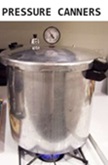
You can make jams, jellies, can fruit, applesauce, salsa and pickles with water bath canners, like this Granite Ware 12-Piece Canner Kit, Jar Rack, Blancher, Colander and 5 piece Canning Tool Set
